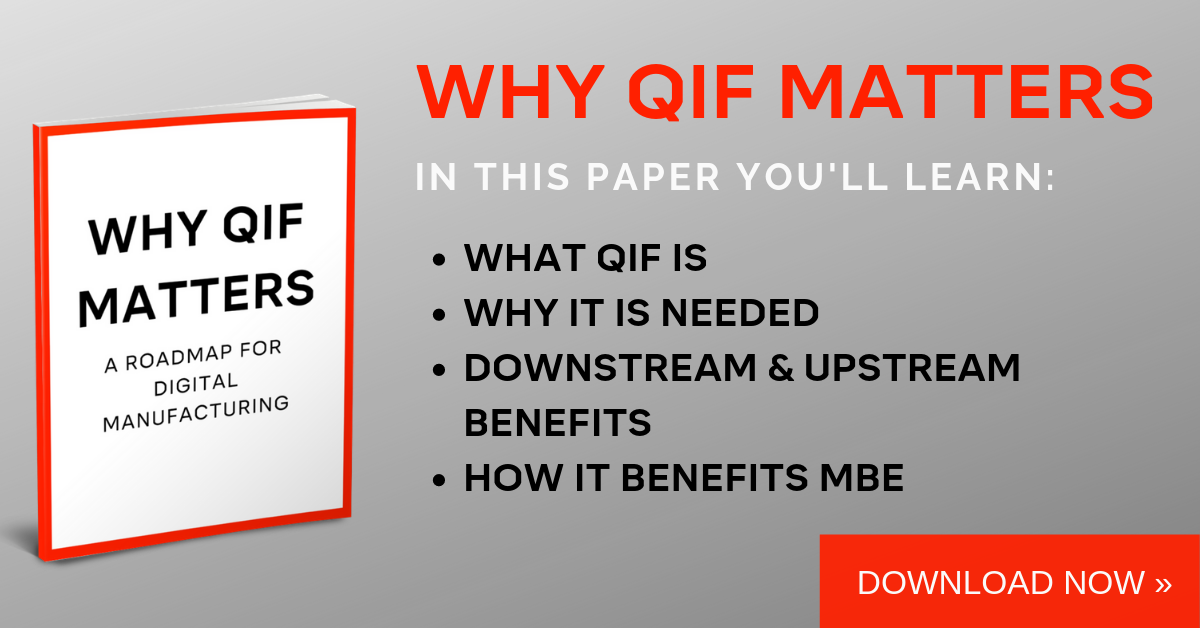A bevy of industry experts, including Daniel Campbell of Capvidia, co-authored a paper that was presented to the NIST MBE Summit in April 2019 about the importance of the Quality Information Framework (QIF) to modern manufacturing.
The paper discusses how the ANSI/DMSC QIF standard provides two benefits to the Model-Based Enterprise (MBE):
- Automation: Automating cyber-physical processes and allowing faster production of high-quality products at lower cost.
- Data traceability: Providing traceability of massive quantities of measurement-related data to the authority product definition model.
These benefits are made possible with meaningful, semantic data packaged in the QIF format.
Using QIF in the Model-Based Enterprise
With Model-Based Definition (MBD) data (i.e., PMI, FT&A, etc.) becoming more commonplace, QIF is an attractive, complete, and unambiguous MBD delivery mechanism for industrial end users. QIF is an open standard CAD format, but with the important addition of semantic PMI.
In addition to automation benefits, QIF helps to provide data traceability in this age of Big Data, where traceability is sorely needed. The Model-Based Enterprise (MBE) provides a paradigm for organizing this data by mapping it all to the master MBD, a process enabled by a product data management (PDM)system.
QIF is designed to support this MBE approach to data management.
Why QIF Matters: A Road Map for Digital Manufacturing explains why QIF is needed and the features built into it to ensure it is equipped to handle the needs of modern industry.
- A feature-based ontology of manufacturing quality metadata.
- A simple implementation and built-in code validation using XML.
- Semantic information linkage to the model for full data traceability to the MBD.
QIF is now a draft international standard (DIS) for ISO, and we expect it to be an ISO standard within months.
Applications of QIF in Manufacturing
QIF is suitable for application to a number of areas:
- MBD using CAD and PMI data. QIF, a CAD data format, provides the base for traceability to authority CAD data.
- A Bill of Characteristics and a Measurement Plan.
- Resources for measurement that specify either basic or detailed information about measurement equipment types such as CMMs, probes, calipers, and gages.
- Rules including measurement templates, macros, and best practices, such as which method to use for the appropriate measurement.
- Harmonization with the ISO/DMIS 5.3.
- Measurement results data associated with the MBD including point cloud data from features.
- Statistics for results sets and specification of the statistical analysis method to be carried out.
Using QIF, MBD provides value in both design as well as operations and deployment.
QIF Roadmap for Success
The software vocabulary and grammar of QIF is defined by XDSL (XML Schema Definition Language) schemas. Feedback from real-world use ensures that QIF retains and builds capabilities required by industry.
QIF provides support for data integrity and integration with current and emerging digital standards. It facilitates software development for the framework. Capvidia will be releasing open source software tools in the future to help the user community create and edit QIF resources and rules.
Why QIF Matters provides clear explanations of the Quality Information Framework, its applications, and what is being done to keep it relevant.
Please don’t hesitate to read this paper, share it with colleagues, and engage with the writers.



.png?width=960&name=qif%20download%20(1).png)

